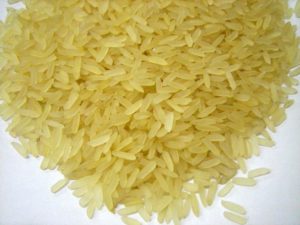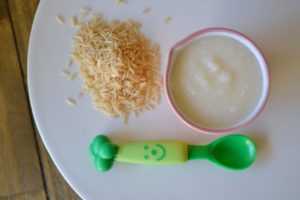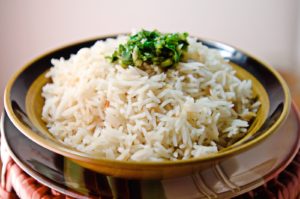Content
- 1 How parboiled rice differs from regular rice
- 2 Composition and calorie content of parboiled rice
- 3 Benefits of Parboiled Rice
- 4 The benefits of steamed rice for weight loss
- 5 Is Parboiled Rice Good for Diabetes?
- 6 Daily intake
- 7 The use of parboiled rice in cooking
- 8 Harm of parboiled rice and contraindications to use
- 9 Conclusion
- 10 Reviews
Steamed rice production technology is designed to retain vitamins and minerals from the top layer of grain, which are lost during normal processing. This explains its popularity in recent years, especially in the diet of athletes and adherents of a healthy diet. The benefits and harms of parboiled rice, how to cook it, and whether it has contraindications, will be discussed below.
How parboiled rice differs from regular rice
When processing with steam, useful substances from the shell pass into the grains. Thanks to this technology, parboiled rice has the following properties:
- prepare faster;
- stay low in calories;
- preserve 80% of trace elements and vitamins;
- do not boil over.

When making ordinary rice, the layers of the upper fibers are removed, and the embryo is cut off during grinding. This is how you get the familiar white rice that looks aesthetically pleasing. During processing, it loses oils, minerals, cellulose, vitamins and protein. The better the grains are polished, the less nutrients remain in them. There is also less benefit.
Composition and calorie content of parboiled rice
The product contains a number of beneficial nutrients:
- proteins;
- carbohydrates - monosaccharides, disaccharides and polysaccharides (pectin);
- lipids;
- B vitamins (thiamine, riboflavin, pyridoxine, pantothenic and folic acid);
- vitamin PP and E;
- trace elements - magnesium, iron, potassium, iodine, fluoride, cobalt, calcium, zinc, manganese, sodium, phosphorus.
The nutritional value of parboiled rice is 123 kcal per 100 g of product, which is 10 kcal less than the calorie content of conventional varieties.
Benefits of Parboiled Rice
Due to the large amount of pectin, the product normalizes the digestive tract and restores the microflora in the intestines. It also stimulates blood circulation and prevents the development of atherosclerosis.

Carbohydrates are a source of energy for the body. Monosaccharides provide nourishment for growing cells, which is especially beneficial in childhood.
Parboiled rice is rich in amino acids: methionine, cysteine, lecithin, choline and lysine, which are involved in the formation of cells and biologically active substances.
The properties of vitamin E and PP are beneficial for skin and hair: they are manifested in the normalization of hormonal levels and in slowing down aging.
B vitamins are beneficial for nerve fibers, memory and mental performance.
Pantothenic acid is involved in the production of glucocorticosteroids and neurotransmitters.
All components of the product play a role in the processes of thermoregulation, energy production and metabolism.
Rice is useful for diseases of the stomach and intestines, accompanied by diarrhea, as well as for poisoning. The enveloping properties of rice mucus protect the stomach walls and make the product indispensable for diseases such as gastritis and peptic ulcer disease.
Parboiled rice has healing properties for the cardiovascular system, as it strengthens the vascular walls, normalizes the heart rate.
The benefits of steamed rice for weight loss
The benefits of parboiled rice for the human body are due to its low calorie content and low starch content compared to regular rice. It causes a feeling of fullness for several hours, therefore it is useful for fasting days and as an element of therapeutic diets.
To unload the digestive system and reduce weight, a mono-diet is used, on which only parboiled rice and water are consumed throughout the period. Spices, butter and sunflower oil, salt are completely excluded.
The property of steamed cereals to absorb water and increase the yield of the finished product by 3 times while maintaining the calorie content is widely used to combat excess weight.
The product also contains "slow" carbohydrates that keep you feeling full after a meal due to their low breakdown rate.

Is Parboiled Rice Good for Diabetes?
Unprocessed rice is beneficial because the partially broken down starch breaks down within a few hours and does not cause hyperglycemia (high glucose levels). It is used in small quantities to diversify the diet. Pre-treatment of grains helps to reduce the glycemic index by 2 times - from 70 to 39 units, which plays an important role in diabetes.
Daily intake
For a healthy adult, it is recommended to eat no more than 150-200 g of parboiled rice per day. For people with diabetes mellitus, the portion should not exceed 100 g. Large portions can be harmful due to the skew in the carbohydrate side.
The daily allowance for children is calculated based on age. For example, for the first feeding, 1 teaspoon of rice porridge is enough. Teenagers 14 - 16 years old can switch to the adult norm.
The use of parboiled rice in cooking
Rice is prepared as a side dish for main courses in combination with sauces or for complex recipes. It is also suitable for desserts - casseroles, puddings. It is also actively used in the preparation of soups, fillings in recipes for pies, cabbage rolls and other dishes.
The undoubted advantage of unprocessed rice is its property not to stick together after cooking, so it is convenient to use it in salads. In the finished form, the dish turns out to be crumbly and fluffy, and after freezing it retains its properties.

How to cook parboiled rice properly
Rice cooking sequence:
- Water is collected in a saucepan and set to heat.
- While the liquid is boiling, rinse the cereal.
- After boiling, the water is salted and rice is poured into it.
- When the liquid has evaporated, turn off the fire.
- Cover the porridge with a towel and let it brew for 10 minutes.
The dish is cooked over low heat under a tightly closed lid. The approximate cooking time is 25 minutes. You can assess the readiness by the color of the porridge: the amber shade should be replaced with white. Porridge goes well with meat, seafood, vegetables and herbs.
Harm of parboiled rice and contraindications to use
Parboiled rice can bring both benefits and harm to health: it all depends on the amount and frequency of consumption of the finished dish. Due to the high content of disaccharides, food cravings can be harmful to obesity and cardiovascular diseases, for example, arterial hypertension or coronary heart disease.
Conclusion
The benefits and harms of steamed rice have been well studied: trace elements, vitamins, essential amino acids are involved in the metabolism and maintenance of homeostasis of the body, on the one hand, while the other extreme of excessive consumption of the product is harmful to increase the risk of heart disease and excess weight.

